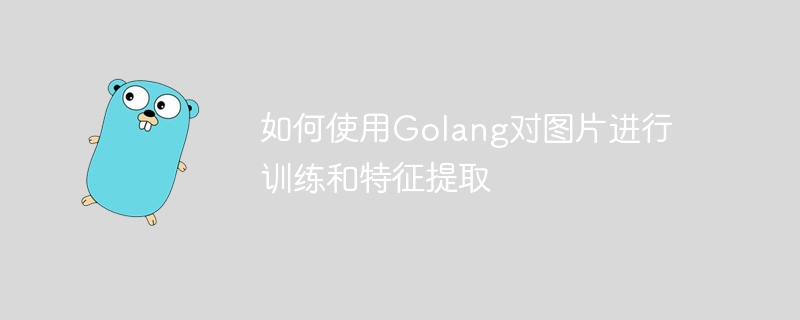Home >Backend Development >Golang >How to use Golang to train and extract features from images
How to use Golang to train and extract features from images
- WBOYWBOYWBOYWBOYWBOYWBOYWBOYWBOYWBOYWBOYWBOYWBOYWBOriginal
- 2023-08-27 14:33:351677browse

How to use Golang to train and extract features from images
Introduction:
In the field of computer vision, training and feature extraction from images is very important. item of work. By training the model, we can identify and classify images, and at the same time extract the features of the image for applications such as image retrieval and similarity calculation. Golang is an efficient and concise programming language. This article will introduce how to use Golang to train and extract features from images.
-
Install necessary libraries
Before we start, we need to install some necessary libraries. First, install Golang’s image processing library goimage package:go get golang.org/x/image/draw
Next, install the image processing library goopencv:
go get github.com/go-opencv/go-opencv
Finally, install the machine learning library goml:
go get github.com/cdipaolo/goml/...
- Data preparation
Before training and feature extraction, we need to prepare the training data set. The training data set should contain positive and negative samples for model training and evaluation. Training data sets can be obtained from image libraries or online resources. -
Image preprocessing
Before training and feature extraction, we need to preprocess the image. Preprocessing includes image size scaling, grayscale conversion and other steps. The following is a sample code for resizing an image:import ( "image" _ "image/jpeg" "log" "os" "golang.org/x/image/draw" ) func resizeImage(inputFile, outputFile string, width, height int) error { // 打开输入图片文件 file, err := os.Open(inputFile) if err != nil { return err } defer file.Close() // 解码图片 img, _, err := image.Decode(file) if err != nil { return err } // 创建缩放后的图片 resizedImg := image.NewRGBA(image.Rect(0, 0, width, height)) draw.CatmullRom.Scale(resizedImg, resizedImg.Bounds(), img, img.Bounds(), draw.Over, nil) // 创建输出图片文件 output, err := os.Create(outputFile) if err != nil { return err } defer output.Close() // 保存图片 err = jpeg.Encode(output, resizedImg, nil) if err != nil { return err } log.Println("Resized image saved to", outputFile) return nil } -
Training model
Next, we can use the training data set to train the model. Taking image classification as an example, the following is an example code for image classification training using the goml library:import ( "log" "github.com/cdipaolo/goml/base" "github.com/cdipaolo/goml/linear" ) func trainModel(trainingData [][]float64, targets []bool) (*linear.Model, error) { // 创建线性分类器 model := linear.NewLogistic(base.BatchGA, 0.001, 1000) // 进行模型训练 err := model.Fit(trainingData, targets) if err != nil { return nil, err } log.Println("Model trained successfully") return model, nil } -
Feature extraction
In addition to image classification training, we can also use The trained model is used for feature extraction. The following is a sample code that uses a trained model to extract image features:func extractFeatures(imagePath string, model *linear.Model) ([]float64, error) { // 加载图片 img, err := openImage(imagePath) if err != nil { return nil, err } // 对图片进行预处理 preprocessedImg := preprocessImage(img) // 提取图像特征 features := model.Predict(preprocessedImg) log.Println("Features extracted successfully") return features, nil }
Summary:
Through the above steps, we can use Golang to train and extract features from images. First, support image processing and machine learning capabilities by installing the necessary libraries. Then, prepare the training data set and images and perform preprocessing. Then, use the training data set to train the model to obtain a model that can be used for prediction. Finally, the trained model is used to extract features of the image.
Golang provides fast and efficient image processing and machine learning libraries, providing good support for our image processing tasks. I hope this article will be helpful to you in using Golang for image training and feature extraction.
The above is the detailed content of How to use Golang to train and extract features from images. For more information, please follow other related articles on the PHP Chinese website!

